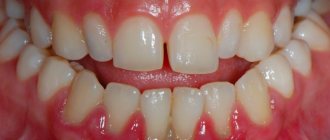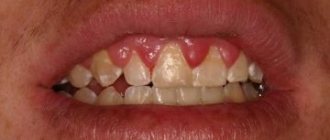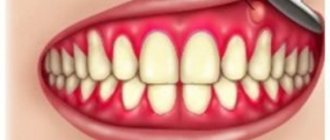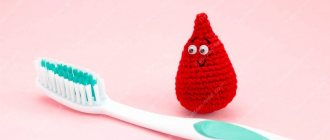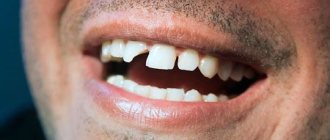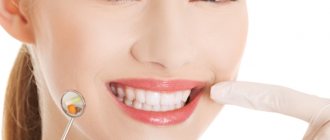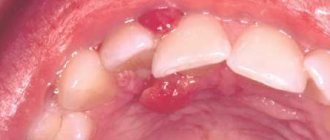Reasons for the development of gingivitis in children
The abundance of causes of the disease can be divided into two large groups.
Common reasons include:
- colds, especially if they occur frequently;
- sore throat and chronic sinusitis;
- hormonal disorders;
- gastrointestinal diseases.
Among the local reasons it is worth highlighting:
- poor-quality fillings, which, when destroyed, injure soft tissues;
- caries (infection from the cavity quickly enters the gums);
- crowded teeth;
- violations during the installation of braces;
- Tight lips that interfere with quality teeth cleaning.
Separately, it is worth noting the most important reason, since all of the above are only a catalyst for the development of the disease. So, the main reason why gingivitis begins to develop is poor oral hygiene, which can manifest itself both in improper brushing of teeth and in incorrectly selected toothpaste and brush.
Symptoms of the disease
Gingivitis has quite a few characteristic signs by which one can guess the onset of the disease:
- bleeding gums;
- pain during cleaning;
- swelling of the gums;
- severe redness of the gums in the case of an acute phase of inflammation;
- when the disease becomes chronic, the gums may acquire a bluish tint.
Often with the naked eye you can notice a large amount of accumulated plaque and tartar, and there may also be many teeth affected by caries.
In addition, gingivitis can be caused by diseases that have nothing to do with the oral cavity:
- heart and vascular diseases;
- disorders affecting the gastrointestinal tract;
- respiratory diseases.
The above factors reduce immunity, as a result of which the gums lose their ability to resist toxins formed in plaque.
What is the best way to treat?
As was said a little above, gingivitis occurs due to accumulated soft plaque, so the first thing you need to do is get rid of it. Plaque can be removed using ultrasound - this is a simple and absolutely painless procedure. Using a special attachment, the dentist touches dental plaque, which is destroyed by ultrasound. By the way, ultrasound allows you to get rid of not only soft plaque, but also hardened formations on the teeth.
It is necessary to understand that plaque can be effectively removed, especially if inflammation has begun, only with ultrasound: rinsing with various means, using special toothpastes and gels with the addition of antibiotics can temporarily remove the symptoms of gingivitis, but these methods are not able to eliminate its cause. As soon as you stop using these medications, bleeding will return and the disease will continue to progress. Therapy aimed at reducing the inflammatory process is justified only after the deposits have been removed.
Anti-inflammatory therapy is usually prescribed as follows:
- Rinse with Chlorhexidine solution. The maximum duration of use of the drug is 10 days. Rinsing should be done twice a day for at least 30-40 seconds per procedure. The solution, which has a bitter taste, which not all children will like, has no contraindications based on the child’s age.
- Rinse with Miramistin (prescribed after the child reaches the age of 3 years). You need to rinse three times a day. The drug is inferior in its effectiveness to Chlorhexidine and is significantly higher in price.
- Rinse with infusions of chamomile or sage (it is not recommended to use oak bark).
In addition to rinses, many doctors prescribe ointments and gels. It is believed that the gel is more effective than ointment because, due to its consistency, it has the ability to remain on the gums for a long time, which promotes better absorption. In addition, the medicinal substances contained in the product penetrate much better into the tissues from the gel than from the ointment.
The most effective and proven gels on the positive side are the following:
- Cholisal is a drug that simultaneously has two effects: analgesic and anti-inflammatory. It is used for gingivitis and the beginning of teething (the drug is rubbed directly into the place where the tooth is emerging). There are no age restrictions. The gel can be used for a maximum of one and a half weeks, twice a day. After applying the product, it is recommended to eat within two, or preferably three, hours.
- Metrogil Denta. Used after 6 years. Apply directly with your finger or a cotton swab to the gums near all teeth; there is no need to rinse off the gel.
Many parents often decide to treat their child on their own, not wanting to see a dentist. But you need to understand that the use of anti-inflammatory drugs will have no effect if you do not get rid of the deposits, so you will still have to set aside time to visit the dentist. If you ignore the advice, then:
- symptoms of bleeding will disappear, but will reappear after completion of the course of therapy;
- gingivitis can become chronic, causing periodontitis.
In addition to anti-inflammatory therapy, oral cavity sanitation and silvering are carried out - a method that does not require drilling, but has a lot of disadvantages.
How to avoid the occurrence of gingivitis?
The following remedies will help prevent gum bleeding:
- High-quality oral hygiene. Parents should instill in their children oral care skills from an early age. Not all adults know that hygiene measures must begin before the first tooth begins to erupt.
- Using the right paste. If the child does not have gingivitis, then you can use any paste designed for children. If your child does not brush their teeth well enough, you can purchase a paste with amino fluoride.
- Stick to your diet - avoid snacking, limit the consumption of fast carbohydrates (carbonated drinks, sweets). Of course, you don’t need to completely deprive your child of sweets, but you can give them only immediately after the main meal, after which you should brush your teeth.
Prevention methods
To avoid the development of inflammation and redness of the gums, you must follow the following recommendations:
- teach your child to brush their teeth correctly using special children’s toothpastes;
- after eating, rinse your mouth, removing remaining particles from the oral cavity;
- Maintain a balanced diet for your child;
- minimize the consumption of confectionery products and sweets, and give the child more vegetables, fruits, dairy products, and fish;
- strengthen the immune system with hardening procedures, gymnastics, and long stays in the fresh air.
Compliance with preventive measures will protect the child from the development of inflammatory phenomena in the gums and the complications that they can provoke.
Bibliography
- Khomenko L.A. – Therapeutic dentistry of children – Kyiv: Medical literature, 2002.
- Persin L.S., Elizarova V.M., Dyakova S.V. - Pediatric Dentistry, Medicine, 2006.
- Kuryakina N.V. - Therapeutic dentistry of children, - Medicine, 2004.
- Ralph E. McDonald, David R. Avery, Jeffrey A. Dean - Dentistry For The Child And Adolescent - Mosby - 2004
- Kuzmina E.M. et al. — Prevention of dental diseases in pregnant women and young children, M., MMSI. 1999.
Find a clinic
Periodontitis and gum disease
Ignoring carious formations leads to the development of pulpitis, which turns into periodontitis. During periods of exacerbation of the disease, you may notice swelling of the gums, and cysts with purulent contents appear.
Vulnerability zone
Let's look at gum disease in children. Your child's healthy gums are delicate and very vulnerable tissue of a pale pink color. Unlike adult gums, they can be easily injured, but they are capable of rapid regeneration. Another peculiarity of children's gums is that they often reflect the general condition of the body, being a litmus test for systemic diseases.
The most common diseases of the gums and periodontal tissues: gingivitis is an inflammation of the gums that occurs as a result of the adverse effects of local and general factors, occurring in 80% of children; gum atrophy, which develops in more than half of the child population; various types of childhood stomatitis, which most often occurs in infants and preschoolers; Periodontitis is a disease in which all periodontal tissues become inflamed and affects up to 5% of young patients. Periodontal disease (dystrophic changes in periodontal tissue) and other pathologies practically do not occur in childhood.
Possible complications
The most common difficulty caused by absent or poor-quality treatment of inflammation of the jaw mucosa is considered to be chronicity. This means that whatever the true cause of the disease, it will become chronic and will recur with every decrease in immunity or stressful situation.
It is difficult to say how vivid the symptoms will remain and whether they will interfere with normal life. Every body is unique and deals with problems differently. In some cases, the disease goes away for years, in others it returns every month.
Another possible complication is a deterioration in the functioning of the immune system, especially the throat, larynx, nose, and ears. Untreated infections often lead to sinusitis, bronchitis, tracheitis and other diseases. With age, other internal organs are also affected.
If your temperature rises
This reaction occurs for almost any reason for inflammation of the mucous membrane, be it infection, periodontitis or simple teething. But depending on which pathogen was the culprit, the increase varies from 37.5 to 39 degrees. The further actions of parents depend on this indicator.
As long as he stays within subfebrile limits, it is enough to give him as much fluid as possible. If a child’s gums hurt and the temperature exceeds 38.5 degrees, you should give him paracetamol in a convenient form and dosage indicated by age.
Remember that even when the fever goes down quickly and does not rise again, you still need to consult a doctor to make an accurate diagnosis. Delaying this moment for an indefinite period can lead to unpleasant consequences.
Associated symptoms
If a child’s gums are swollen and painful, and a baby tooth can already be clearly felt through it, parents can help the child cope with the pain by rubbing in anesthetic ointments. But teething is often a protracted process, so the pathology can torment children at different intervals without obvious signs such as redness or inflammation. Even in this case, you can understand the reason for the baby’s bad mood by additional signs:
- Changes in appetite (usually to a lesser extent, since chewing food becomes painful).
- Poor shallow sleep.
- Irritability and moodiness.
- Increased attention to the pacifier (the baby either throws it away or asks for it again).
If a child 3 years of age or older has gum pain, he will be able to tell about it himself, but a smaller child will have to be monitored much more closely.
